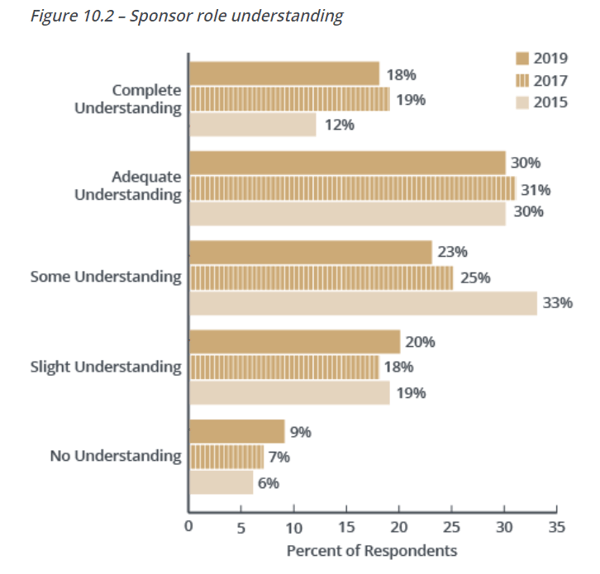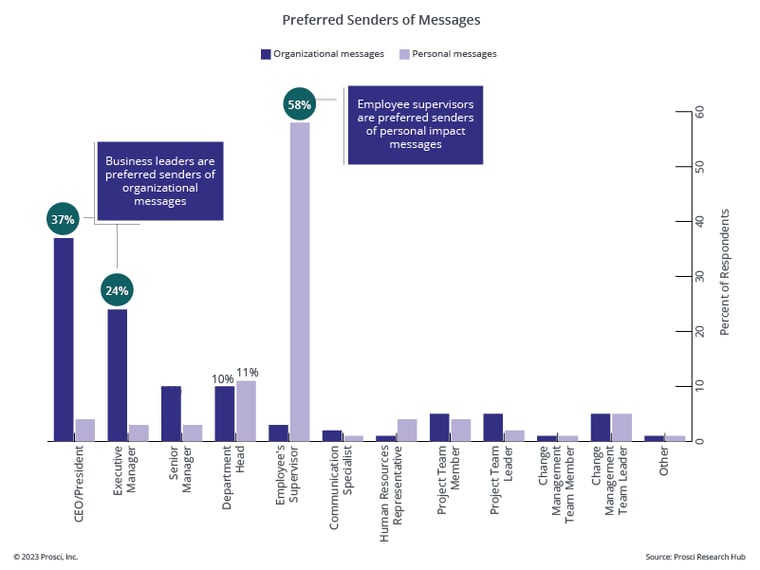Sponsor Checklist for Change Management

3 Mins
Updated: October 31, 2025
Published: April 19, 2021

Do your sponsors understand their role in change and its correlation with success? Are they equipped to perform their critical role? As a change practitioner, how do you know if you are doing all you can to enable them effectively?
Prosci's Best Practices in Change Management benchmarking studies have been exploring sponsorship effectiveness for more than two decades. Using key findings from the research, we created this simple checklist to use when engaging senior leaders in your initiatives.
Sponsorship Checklist
1. Have you made your sponsor aware of their importance to successful change?
Every Prosci Best Practices in Change Management report identifies active and visible sponsorship as the number one contributor to successful change. Similarly, respondents cite a lack of executive support and active sponsorship as the top obstacle to change management success.
2. Have you equipped your sponsor to perform the ABCs of Sponsorship?
Prosci research clearly shows that senior leaders must perform three critical roles during change. As primary sponsors, senior leaders must:
- Actively and visibly participate throughout the project
- Build a coalition of sponsorship with other leaders
- Communicate support and promote the change to impacted groups
In the most recent benchmarking study, 52% of respondents said their sponsors did not have an adequate understanding of their role in change.

3. Is your sponsor actively and visibly participating throughout the entire project?
Sponsors must do more than sign the project charter. Effective sponsors engage with the change throughout the life of the project, from the kickoff to project completion. To be successful, sponsors cannot "launch and leave" or take a backseat role in change.
4. Are you enabling your sponsor to build the coalitions of support necessary for successful change?
Primary sponsors of change must enlist support from other leaders, who act as sponsors of the change in their areas of the organization. Best practices research shows that effective sponsor coalitions:
- Engage across the organization
- Create, coach and maintain a network of active and committed change agents
- Communicate the importance of role-modeling the change, and encourage senior leaders to participate and support the change
- Cultivate management support of the project
- Ensure alignment of expectations among people managers
- Clarify roles
- Solicit and openly receive management feedback
5. Do your sponsors communicate directly and effectively with people in the organization?
The research shows that employees prefer to receive messages about organizational change directly from senior leaders. To be effective sponsors of change, they themselves must communicate the business reasons for the change, the risks of not changing, and why the change is happening now.

6. Are you helping your sponsor avoid the biggest mistake sponsors make during change?
The biggest mistake sponsors make is failing to personally engage as the sponsor during the change. The high rate of failure includes not participating throughout the entire project, abdicating their role to lower-level managers or the project team, and failing to communicate the reasons for change with immediate employees. Project teams face tremendous difficulties when they have a sponsor who does not personally engage in the change.
7. Have you fully prepared and equipped your sponsor to manage resistance?
Managing resistance to change is a key role of senior leaders and people managers. In addition to the work change teams do to identify the root causes of resistance and plan for mitigating resistance early in the change management process, sponsors must be ready and able to mitigate resistance when it occurs, especially with other senior leaders and people managers. As a change practitioner, it is your job to coach senior leaders on how to identify the root causes of resistance and engage with impacted people and groups effectively.
8. Is your sponsor ready, willing and able to celebrate successes?
Celebrating successes (even small, short-term successes) is an important part in building support and momentum for your changes. Sponsors play a key role in recognizing employees both publicly and privately.
9. Is your sponsor prioritizing the change management initiative and related work?
Sponsors greatly influence others through their behaviors, actions and communications. Sponsors must demonstrate their commitment to a change, as well as the organization's commitment, if they expect people throughout the organization to engage with it.
10. Are you helping your sponsor avoid "flavor of the month" syndrome?
Some organizations fall into a habit of regularly introducing new initiatives and abandoning them or failing to follow through adequately. This "flavor of the month" situation makes it very difficult to create any meaningful change in an organization. Sponsors are responsible for launching new initiatives and ensuring that these initiatives get the follow-through, resources and commitment they need to succeed.
Help Sponsors Engage in Change
Senior leaders play a critical role as primary sponsors and members of sponsor coalitions during change. Without effective sponsorship, change efforts often struggle. But when you leverage best practices to prepare, equip and support your sponsors effectively, you set up your entire organization for successful change.




